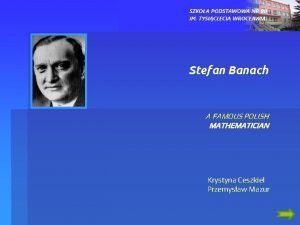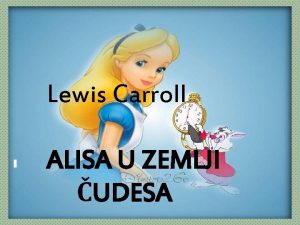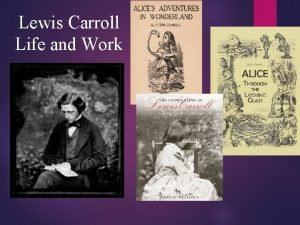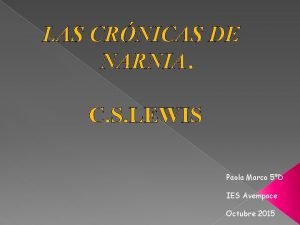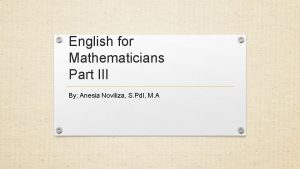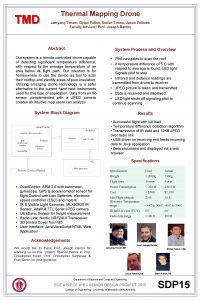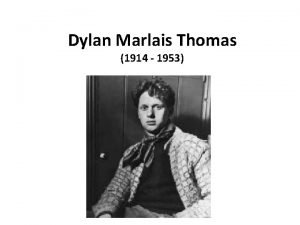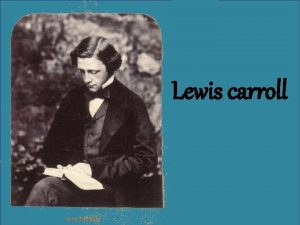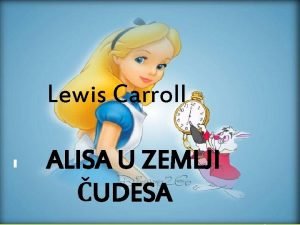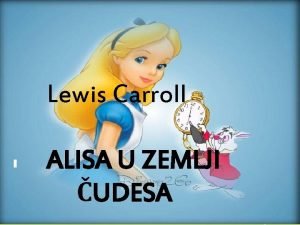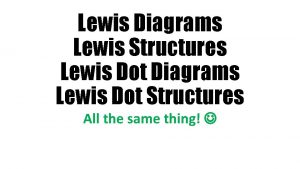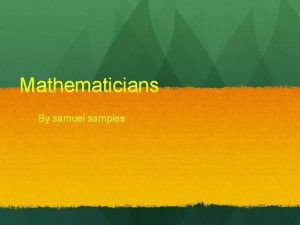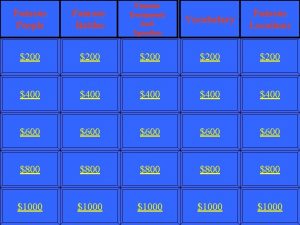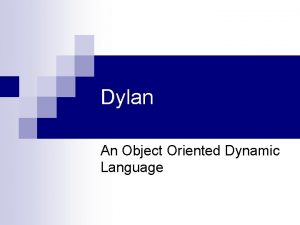Famous Mathematicians Dylan Cimadon Lewis Carroll Lewis Carroll
















- Slides: 16

Famous Mathematicians Dylan Cimadon

Lewis Carroll • Lewis Carroll, was born Charles Lutwidge Dodgson • He was born 1832 in Britain and died in 1898 • His Claim to Fame Lewis Carroll is best known for "Alice's Adventures in Wonderland", and "Through the Looking Glass", but he also had a BA degree in mathematics, was a lecturer, an the author of two mathematical textbooks, which were published under his birth name, Charles Lutwidge Dodgson. The name "Lewis Carroll", was an adaptation of Carolus Lodovicus, his Latinized name. In addition to literature and mathematics, Carroll was a photographer, and an accomplished Illustrator.

• He went up to Oxford in 1850 after six unhappy years in English “public” schools. At the end of 1852 he was given first class honors in mathematics and was appointed to a “studentship” on condition that he remain celibate. He took his B. A. with first class honors in the final mathematical school in 1854 and his M. A. in 1857. In 1855, at the age of 23, he was given a scholarship that paid the princely sum of 20 pounds a year, and was appointed senior student, or don, at Christ Church, and mathematical lecturer in the University. He lived, a bachelor, in college in Tom Quad from 1868 until he died, 66 years old, in 1898.

Leonardo Da Vinci He was born in Italy in 1452 and died in 1519 • He was a genius and artist; not a "true" mathematician, but Leonardo's such an inspiring force, that he deserves a spot as a famous mathematician. • His claim to fame was a few things. He was a Painter, sculptor, draughtsman, architect, engineer, anatomist, physicist, astronomer, observer of life in all its forms, and most of all, great thinker. Leonardo is one of our history's most admired geniuses, centuries ahead of his time, one of the first artists to seamlessly merge science and art. Although he only completed 6 major paintings in his entire career, they include some of the most important images ever known.

• Da Vinci's approach to the future, his inventions, his drawings of his inventions are inherently wrapped around problem solving and reasoning. He formulates problem construct approaches, as drawn in the Codex, The Mona Lisa Bridge, Bird, and Helicopter. A Codex is the early form of a book, developed by the Romans from wooden writing tablets.

Johannes Kepler He was born 1571 and died in 1630 • He was a German astronomer. Johannes Kepler was one of the most important scientist in the field of astronomy. He was the founder of "celestial mechanics", having been the first to explain planetary motion. Also including his ideas on the structure of the Universe, Kepler made important headway into the field of optics, his book Stereometrica Doliorum formed the basics of integral calculus, and he also made important advances in geometry. • In addition to these major breakthroughs, Kepler is responsible for the three laws of planetary motion.

Kepler’s Three Laws. • Kepler's first Law: The orbit of a planet about the Sun is an ellipse with the Sun's center of mass at one focus. • Kepler's second Law: A line joining a planet and the Sun sweeps out equal areas in equal intervals of time. • Kepler's third Law: The squares of the periods of the planets are proportional to the cubes of their semi-major axes.

Leonardo Pisano Fibonacci, a. k. a. "Leonardo of Pisa", and "Leonardo Bigollo". • He was born 1770 and died 1250 • Leonardo Fibonacci is responsible for having introduced the decimal system in Europe, adapting the methods of arithmetic he had learned from the many Arabic and Indian traders he meet while spending time along the Mediterranean coast with his father, a merchant and customs officer in North Africa. In his text "Liber Abaci", Fibonacci determined that by using the Indian numbers of 1 to 9, and the Arabic symbol Zephirum, or Zero (0), one could write any number.

Fibonacci • Tried to figure out how rabbits reproduced by using a series of numbers we now call the Fibonacci series.

Benoit Mandelbrot • He was born 1924 and has yet to die. • Benoit Mandelbrot is the IBM researcher who successfully showed the occurrence of fractal patterns in nature and in mathematics, and has become somewhat of a pop culture icon due to the interest in fractal geometry generated by his work during the early 1990 s. • Although I did a project on him last year I still find him interesting enough to write about.

Blaise Pascal • He was born 1623 and died 1662 • Blaise Pascal is believed by many to have invented the very first digital calculator, which he called the "Arithmetic Machine". In addition to being a mathematician, Pascal was also a physician, and a theologian, as were most of the scientists of the age.

Johann Radon • He was born 1887 and died 1956. • Johann Radon applied the calculus of variations to differential geometry, leading to applications in number theory. “Mathematically, a projection can be described by the Radon transform, which is to transform two-dimensional images with lines into a domain of possible line parameters, where each line in the image will give a peak positioned at the corresponding line parameters. ”

Erwin Shrodinger • Born 1887 and died 1961 • Erwin Schrödinger was the first physicist to study wave mechanics. His equations about undulation explained the behavior of electrons in atoms. He was awarded the 1933 Nobel Prize for Physics for his contribution to the field.

George Boole • He was born 1815 and died 1864. • George Boole is a self-taught scholar, teacher, mathematician and linguist who invented Boolean algebra, a form of symbolic logic in which "true" or "false" are the only two greatest possible values.

References • • • http: //www. famousmathematician. com/default. htm http: //www. famousmathematician. com/profiles/lewis_caroll. htm http: //www. famousmathematician. com/profiles/sir_isaac_newton. htm http: //www. famousmathematician. com/profiles/leonardo_da_vinci. ht m http: //www. famousmathematician. com/profiles/johannes_kepler. htm http: //www. famousmathematician. com/profiles/leonardo_fibonacci. ht m http: //www. famousmathematician. com/profiles/benoit_mandelbrot. ht m http: //www. famousmathematician. com/profiles/blaise_pascal. htm http: //www. famousmathematician. com/profiles/johann_radon. htm http: //www. famousmathematician. com/profiles/erwin_schrodinger. ht m http: //www. famousmathematician. com/profiles/george_boole. htm

Closing page Hope you kind of liked it. • this was made by the coolest kid in the west.
 Polish mathematician stefan
Polish mathematician stefan Mathematician names
Mathematician names Lorena little lewis carroll
Lorena little lewis carroll Lewis carroll elementary school calendar
Lewis carroll elementary school calendar Alisa u zemlji čudesa
Alisa u zemlji čudesa Lewis carroll
Lewis carroll Jabberwocky poetic devices
Jabberwocky poetic devices Lewis carroll wonderful
Lewis carroll wonderful Lewis carroll ppt
Lewis carroll ppt C-s lewis structure
C-s lewis structure Lewis carroll
Lewis carroll Thomas combe
Thomas combe English for mathematicians
English for mathematicians Dylan fallon
Dylan fallon Gdworkshop
Gdworkshop Dylan ryder model
Dylan ryder model Dylan thomas in my craft
Dylan thomas in my craft
